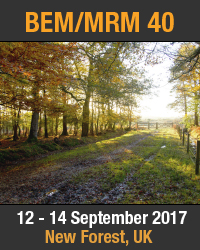40th International Conference on Boundary Elements and other Mesh Reduction Methods
12 - 14 September, 2017
New Forest, UK
Introduction
The annual conference on Boundary Elements and other Mesh Reduction Methods (BEM/MRM) started in 1978 and is now in its 40th version. It is well established as the recognised international forum for the latest advances in those techniques and their application in science and engineering.
The continued success of the meeting is a result of the strength of the research on boundary elements and mesh reduction techniques being carried out all over the world. The conference has continually evolved in line with the latest developments in the field since the successful development of boundary integral techniques into BEM was reported in the first meeting held in Southampton in 1978.
The objective of the research papers presented at the meetings is the further development of techniques that reduce or eliminate the type of meshes required by first generation computational methods, such as finite differences or finite elements. This has steadily been achieved through the development of BEM as a computational tool and continues through more recent research into advanced techniques, leading to further mesh reduction aiming to produce truly meshless methods.
The meeting also encourages the presentation of papers on the use of BEM and, in particular, the description of new applications. Problems related to interface with other techniques, processes such as finite elements, the solution of large systems of equations and the direct coupling of BEM to design and manufacturing are also welcome.
All the meetings since 1978 have produced a series of edited volumes in which the major developments in the field have been presented. This valuable collection has been in digital form since 1993 with the papers available Open Access in the Wessex Institute’s eLibrary website (http://www.witpress.com/elibrary) where they can be easily accessed and downloaded.
The continued success of the meeting is a result of the strength of the research on boundary elements and mesh reduction techniques being carried out all over the world. The conference has continually evolved in line with the latest developments in the field since the successful development of boundary integral techniques into BEM was reported in the first meeting held in Southampton in 1978.
The objective of the research papers presented at the meetings is the further development of techniques that reduce or eliminate the type of meshes required by first generation computational methods, such as finite differences or finite elements. This has steadily been achieved through the development of BEM as a computational tool and continues through more recent research into advanced techniques, leading to further mesh reduction aiming to produce truly meshless methods.
The meeting also encourages the presentation of papers on the use of BEM and, in particular, the description of new applications. Problems related to interface with other techniques, processes such as finite elements, the solution of large systems of equations and the direct coupling of BEM to design and manufacturing are also welcome.
All the meetings since 1978 have produced a series of edited volumes in which the major developments in the field have been presented. This valuable collection has been in digital form since 1993 with the papers available Open Access in the Wessex Institute’s eLibrary website (http://www.witpress.com/elibrary) where they can be easily accessed and downloaded.
Conference Topics
The following list covers some of the topics to be presented at BEM/MRM 40. Papers on other subjects related to the objectives of the conference are also welcome.
- Advanced formulations
- Advanced meshless and mesh reduction methods
- Structural mechanics applications
- Solid mechanics
- Heat and mass transfer
- Electrical engineering and electromagnetics
- Computational methods
- Fluid flow modelling
- Damage mechanics and fracture
- Dynamics and vibrations
- Engineering applications
- Interfacing with other methods
- Coupling with design and manufacturing
- Solution of large systems of equations
Find out more on the conference webpage.
